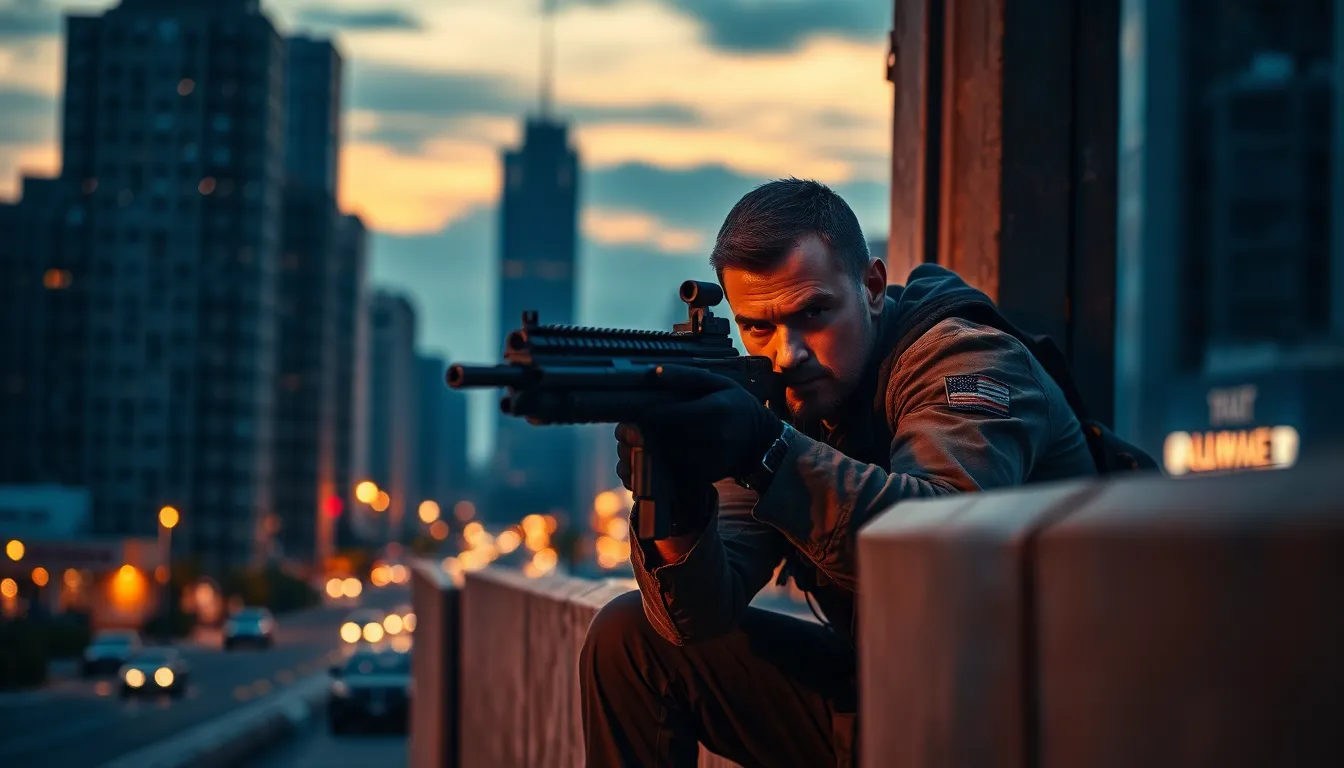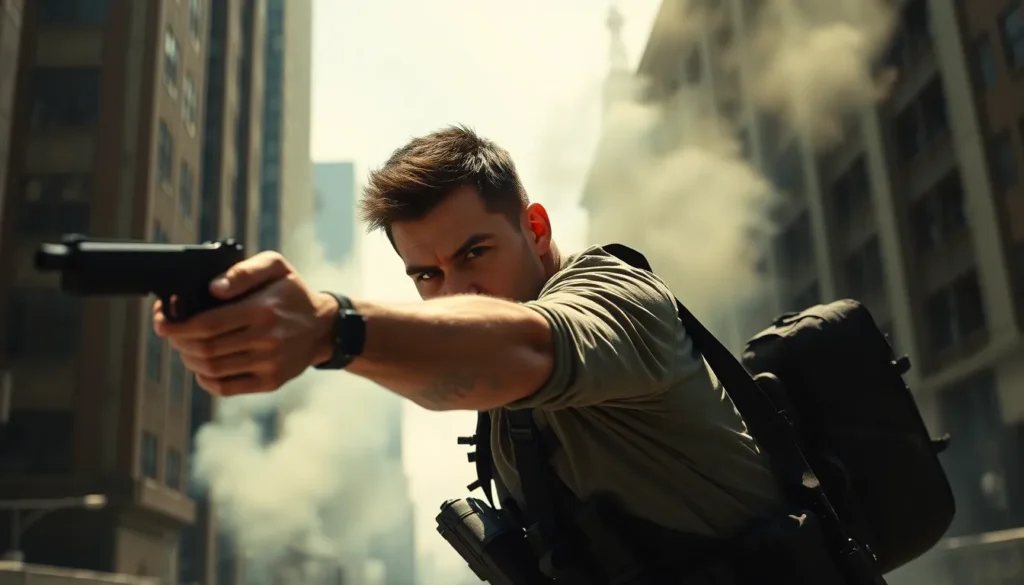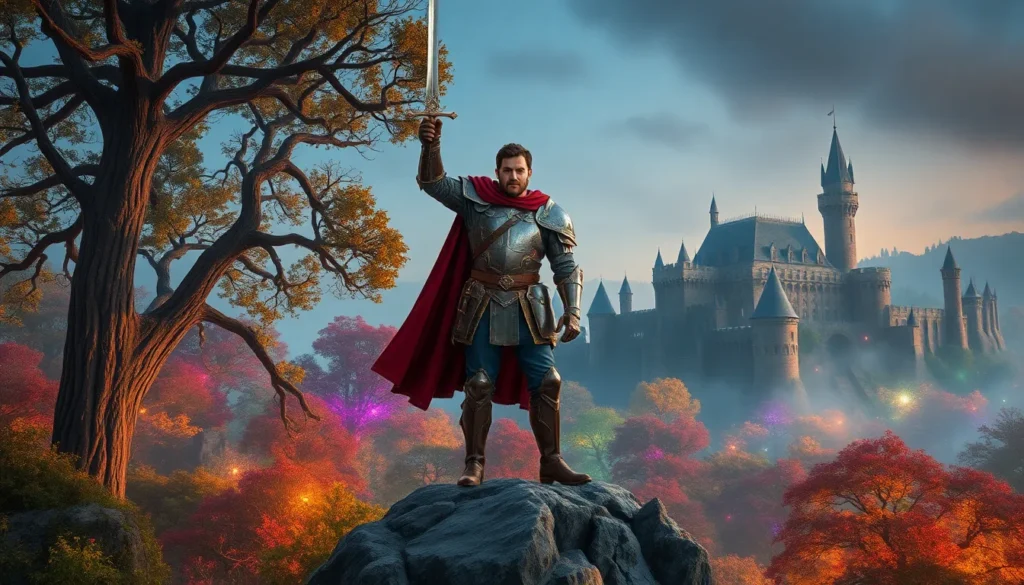Table of Contents
ToggleAction films are the roller coasters of cinema, whipping audiences through thrilling chases and explosive confrontations. But what really brings those heart-pounding moments to life? It’s the magic of cinematography. This art form transforms ordinary scenes into breathtaking spectacles, making viewers feel every punch, explosion, and hairpin turn.
Overview of Action Film Cinematography
Cinematography in action films stands out due to its dynamic visual storytelling. It captures high-octane sequences that engage viewers, enhancing the thrill of both chases and confrontations. Techniques such as rapid camera movements and tight framing immerse the audience, creating an adrenaline-fueled experience.
Employing various camera angles and shot compositions emphasizes both scale and intensity. Wide shots often showcase expansive landscapes or sets, while close-ups isolate characters during pivotal moments. This juxtaposition draws attention to critical emotional beats amidst chaotic action.
Lighting plays a key role in establishing mood and tension. Harsh lighting accentuates the drama of fight scenes, while softer hues can create suspenseful atmospheres. Color palettes also contribute to the overall aesthetic; warm tones can evoke excitement, whereas cooler tones may suggest danger.
Editing styles significantly influence the pacing of action sequences. Fast cuts might generate urgency and excitement, while longer takes can build suspense. Synchronization between the camera work and the soundtrack enhances the impact, allowing audiences to feel the rhythm of the action.
Cinematographers often collaborate closely with directors to achieve specific visual goals. Each technical decision carries the weight of the narrative, ensuring that every frame aligns with the film’s overall vision. Techniques such as handheld camera work can heighten realism, making audiences feel as if they are part of the action.
Audiences respond positively to these cinematic techniques. Engaging visuals and clever editing contribute to the film’s success, making action films memorable experiences. In conclusion, effective cinematography captivates viewers, serving as a fundamental pillar in the success of action films.
Key Techniques in Action Cinematography


Effective action cinematography relies on a variety of techniques that enhance the visual storytelling experience. Key elements include camera angles, movement, lighting, and color grading.
Camera Angles and Movement
Dynamic camera angles intensify action sequences and immerse viewers in the narrative. Low angles can enhance a character’s power, while high angles create vulnerability. Wide shots establish context and allow for greater spatial awareness, while close-ups bring focus to characters’ emotions and reactions. Rapid camera movements, such as pans and tilts, convey energy and urgency. Handheld shots often produce a sense of realism during chase scenes. Ultimately, the combination of diverse angles and movement styles creates a compelling visual rhythm that draws audiences into the action.
Lighting and Color Grading
Lighting plays a crucial role in establishing mood and atmosphere. Harsh lighting can amplify tension during confrontations, while softer lighting generates suspense during quieter moments. Color grading further influences perceptions; warm tones convey excitement, whereas cooler tones hint at danger. Shadows and contrasts shape character dynamics and contribute to overall storytelling. A well-executed color palette aligns with the film’s themes, enhancing the emotional impact of each scene. Together, lighting and color grading create a visually cohesive experience that captivates viewers throughout the film.
Iconic Action Films and Their Cinematography
Cinematography plays a pivotal role in shaping iconic action films. Through unique techniques, these films create unforgettable visual experiences.
Case Study: Film A
“Mad Max: Fury Road” exemplifies stunning cinematography in action films. Dynamic camera movements enhance the feeling of speed during high-octane car chases. Close-ups of characters during intense moments emphasize their emotions, creating a deeper connection with the audience. The film utilizes wide shots to showcase the vast desert landscape, highlighting both isolation and danger. Harsh lighting brings out the film’s gritty mood, amplifying the urgency felt throughout the narrative. Color grading also plays a significant role, with warm tones conveying excitement amidst chaos.
Case Study: Film B
“John Wick” showcases masterful cinematography with its fluid action sequences. Innovative shot compositions draw audiences into the world of the titular character. Handheld camera work during fight scenes generates a visceral sense of realism that immerses viewers. Soft lighting contrasts sharply with intense action, enhancing suspense. The use of longer takes allows audiences to appreciate complex choreography, making each movement impactful. Cooler tones in the color palette suggest danger, keeping viewers on edge while following John Wick’s relentless pursuit.
The Role of the Cinematographer in Action Films
Cinematographers play a crucial role in defining the visual language of action films. Dynamic camera movements enhance the intensity of high-stakes chases, allowing viewers to feel the adrenaline of each sequence. By employing various camera angles, they emphasize the scale of epic confrontations, combining wide shots with close-ups to create emotional depth.
Lighting techniques, such as harsh lighting, amplify dramatic moments, while softer hues can evoke suspense. Color palettes also shape the film’s mood; warm tones signal excitement, contrasting with cooler tones that suggest lurking danger. Each visual decision contributes to the narrative experience, reinforcing emotional connections.
Editing styles significantly influence the pacing of action sequences. Fast cuts generate urgency, pulling viewers deeper into the action, while longer takes provide moments of suspense and anticipation. Synchronizing camera work with the soundtrack enhances the immersive experience, allowing audiences to feel the rhythm of the unfolding drama.
Cinematographers collaborate intimately with directors to align visual storytelling with narrative goals. Techniques like handheld camera work boost realism, especially during chase scenes, creating a visceral connection with the action. Each shot composition and movement serves a purpose, driving the story forward while maintaining engagement.
Iconic action films demonstrate the power of effective cinematography. “Mad Max: Fury Road” showcases dazzling visual storytelling with sweeping landscapes and close-ups that capture character emotion. “John Wick” employs fluid camera movements and innovative compositions, immersing audiences in meticulously choreographed fight scenes. These examples underline how critical cinematography is in crafting compelling narratives and unforgettable experiences in action cinema.
Emerging Trends in Action Film Cinematography
Technological advancements shape emerging trends in action film cinematography. Digital cameras now capture high-resolution images, enabling cinematographers to deliver stunning visuals. Drones introduce dynamic aerial shots, showcasing the scale and intensity of action sequences from unique vantage points.
Virtual reality technology transforms audience experiences, allowing immersion in action scenes. Filmmakers increasingly experiment with 360-degree cinematography, creating a more interactive engagement. The use of practical effects, such as real explosions and stunts, gains popularity, as it enhances authenticity and visual impact.
Innovative lighting techniques also play a crucial role in modern cinematography. Cinematographers now favor LED technology for flexibility and color accuracy, resulting in more controlled and dynamic visual storytelling. Enhanced color grading in post-production creates striking contrasts, directly influencing viewer emotions.
Editing styles continue evolving alongside these cinematographic techniques. Rapid cuts remain effective for intense sequences, while longer takes can build suspense during crucial moments. Motion graphics and CGI integration allow seamless transitions between reality and fantasy, enhancing visual storytelling.
Influential directors often collaborate with cinematographers to achieve a distinctive style. The synergy between them shapes the film’s unique visual language, blending cohesive storytelling with thrilling cinematography. As the industry evolves, these trends redefine how action films engage and captivate audiences.
Cinematography is the heartbeat of action films driving the excitement and emotional engagement that audiences crave. Through innovative techniques and dynamic visuals cinematographers create a thrilling ride that immerses viewers in every chase and confrontation. As technology advances the collaboration between directors and cinematographers continues to redefine the visual landscape of action films.
Emerging trends like digital imaging and virtual reality are pushing boundaries offering new ways to experience the adrenaline rush. With each new film the art of cinematography evolves ensuring that action sequences remain captivating and unforgettable. This ongoing evolution not only enhances storytelling but also deepens the connection between the audience and the cinematic experience.




